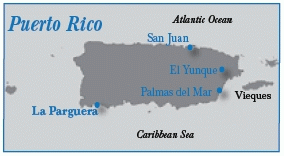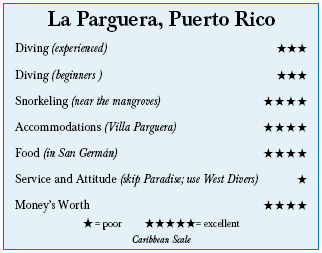La Parguera, Puerto RicoContents of this Issue: Komodo Dancer, Flores Sea, Indonesia Did Gabe Watson Get Away With Murder? Dive Instructor Jailed for Being Alone With Her Boss Divers, You’re Not Using Enough Sunscreen Can Saunas Prevent Decompression Sickness? Go Where No Diver Has Gone Before Where Have Hawaii’s Fish Gone? Passport Tips for Traveling Divers Dive Gear Warranties: Always Honored? Editorial Office: Ben Davison Publisher and Editor Undercurrent 3020 Bridgeway, Suite 102 Sausalito, CA 94965 an okay dive destination close to home from the July, 2009 issue of Undercurrent
Dear Diver: It might not occur to some hardcore divers that there are plenty of others who are content with just a few dives and a lot of topside exploring. On some vacations, I’m one of those and I recently found that Puerto Rico, a long weekend non-stop trip from many U.S. airports, is a good choice and easy on the budget. I rented a car at San Juan’s airport and after negotiating afternoon rush-hour
traffic, it was an easy two-and-a-half-hour drive through lush emerald mountains to
Ponce, then alongside the Caribbean until I reached Lajas, a village on the southwestern
coast. My pleasant room in the Villa Parguera, the largest and best hotel in
town, was $100 a night, with two queen beds. I showed up at Paradise Scuba at 8 a.m., put my gear into their truck and walked a block to the boat dock. By 8:45 a.m., our crowded boat of eight divers was heading out to the wall. The first three miles were protected from the wind and surf by mangroves and barrier islands, but the next three were wet for anyone not under the cover. Black Wall, thickly dotted with shrubs of silvery black coral, is one of La Parguera’s signature sites. I followed the mooring line down through swarms of durgeons hoping for scraps. I went over the lip of the wall into endless blue, then cruised at 85 feet. I checked out a green tube tunicate while Cachi, the divemaster, pointed out a green moray in the open. My partner, upside down peeking into a hole, pantomimed a drumbeat to signal a black drum but it turned out to be a highhat. A large queen angelfish buddied up alongside me. Nice, but it was the largest fish I saw on this dive. The snappers, groupers, jacks, even the big parrots are fished out (not unlike some other Caribbean destinations). During our one-hour interval, Cachi moved the boat to the next site, then passed around cookies, sandwiches and cold drinks. Then, a giant stride into the water at Forest. After deeper first dives on the Parguera Wall, the second dives are on the patch reef with a sandy bottom at 50 to 60 feet. The water was 80 degrees in March; I used my 3mm jumpsuit and never chilled on the 45-minute dives. Cachi didn’t seem interested in leading or even giving a briefing, so my buddy and I eased around the sand channels and over the tongues of coral, where blackbar soldierfish and butter hamlets lived. Tiny ghost feather dusters grew in the sand. The coral cover was half dead on the back reef, a little better on the walls. Cachi told me there was a sustained period of 87-degree water a few years ago, and the reef had suffered. By 1 p.m., I was back at the dock. I hosed down my equipment before loading it on the truck, and hung my wetsuit in the shop. Because Paradise does only two dives per day, I used my afternoons to explore the nearby towns, parks and beaches. It was a treat to take the 40-minute drive to Guánica, a rare, dry tropical forest with deciduous trees and cacti growing taller than my six-foot self. The park has lots of trails, some running from 500-foot-high hillsides down to the sea. Another afternoon, I drove west to the Cabo Rojo lighthouse at the southwestern tip of Puerto Rico to walk along towering sea cliffs, wade on a nearly-deserted sparkling beach, and enjoy the shorebirds in the salt flats. As a bilingual and bicultural island with American influence all over the place, Puerto Rico is gringo-easy, and the prices are generally easy on the wallet. Parguera has the feel of any American beach town. It’s a friendly place, with take-out shops, open-air bars with pinball machines and lots of young folks, especially on the weekends. Effects of the economic downturn were visible, as several restaurants and hotels had closed. Our dinners at the Villa Parguera were either overcooked or underdone, but in the morning I had a simple, cheap breakfast with excellent coffee and a chat with the co-owner at the little diner attached to the Supermercado Perez, a block from the hotel. To skip the crowds, head for San Germán, a 15-mile drive inland. It’s the second-oldest town in Puerto Rico, after San Juan. At the end of the long town square is a museum in what’s left of a church founded in 1606. It’s a world apart from the noisy beach town. On the square, I sampled three restaurants in as many evenings, with the clear winner being the aptly-named Tapas Café. On my last dive day, I visited Cañones and a gently sloping wall, where I cruised through 15-foot-deep channels. The sun was out, the visibility was at least 80 feet, and the coral was healthier here. Above one coral spur, a school of creole wrasse hurried past me, and I saw many tomtates, an uncommon type of grunt. I followed a trumpetfish, its nose bright purple. When it began its part-of-a-seafan act, its nose lost its color. A diver was set to take a picture of an eight-foot nurse shark snoozing in the sand, but Cachi pulled its tail and chased it off. He had the unconscionable habit of harassing animals, even inflating the puffers, then delivering them to divers. On my final dive at Estrella, I followed a small school of striped goatfish as they dug for morsels. At the end of a coral spur, I found a male hogfish lying on his side; even a close approach didn’t stir him from his snooze. The Paradise dive shop has little to recommend it: no O2 kit, rinse tank or even a mask bucket. The head was broken, the underwater guiding was listless. I tried to book the other dive shop, West Divers, but its boat was full. Based on my visit to their shop, I’d book there next time. They also have afternoon dives. One afternoon, my buddies and I rented a boat and outboard ($50 for three hours) to snorkel mangrove islets one mile out to sea. Many divers believe they graduated from snorkeling long ago, but at these mangroves and the nearby turtle grass, one enters a different underwater world - - the reef’s nursery, replete with juvenile baby grunts, wrasses, barracuda, and schoolmasters. Hundreds of upside-down jellies abounded, some pulsating along in mid water. All this in less than six feet of water.
After four days in La Parguera, I drove east to El Yunque, the spectacular tropical forest park, for walking, birding and lounging on a little terrace at the beautiful eco-lodge Casa Cubuy. Then on to Old San Juan for a day-long walking tour through history. Indeed, Puerto Rico offered me a fine assortment of activities above and below the surface for a good price. -- M.A. P.S. If you’re staying in San Juan, reader Mark Zahorik (Chicago, IL), who dived Puerto Rico in April, recommends a good alternative. “A 45-minute drive to the southeast coast gets you to Palmas Del Mar resort, which has a new dive operation called East Puerto Rico Diving. It was launched by Joe LeRoy, a retired stockbroker turned avid scuba instructor. Basslet Reef, a large reef formation just outside the large harbor, stretches for several miles, and the visibility on the deeper first dives was consistently near 100 feet. The area appears overfished so larger pelagics are infrequent, but I saw turtles and rays on most dives. A bonus with this location is that LeRoy often elects to make the 12-mile trip over to Vieques. There are several shallow reefs off the island that he often visits when the group has newer divers, and they appear healthy and unspoiled by fisherman. The sites near Palmas del Mar are also solid. Moray’s Ledge was particularly notable. In addition to getting an upclose view of a six-foot green moray eel, we also had a sea turtle follow us around for five minutes. I saw several lobsters, a spotted eagle ray with remora attached, an octopus along with schools of grunts, spadefish and angelfish, all in 100 feet of visibility.”(www.eastpuertoricodiving.com)
|

I want to get all the stories! Tell me how I can become an Undercurrent Online Member and get online access to all the articles of Undercurrent as well as thousands of first hand reports on dive operations world-wide
| Home | Online Members Area | My Account |
Login
|
Join
|
| Travel Index |
Dive Resort & Liveaboard Reviews
|
Featured Reports
|
Recent
Issues
|
Back Issues
|
|
Dive Gear
Index
|
Health/Safety Index
|
Environment & Misc.
Index
|
Seasonal Planner
|
Blogs
|
Free Articles
|
Book Picks
|
News
|
|
Special Offers
|
RSS
|
FAQ
|
About Us
|
Contact Us
|
Links
|
3020 Bridgeway, Ste 102, Sausalito, Ca 94965
All rights reserved.

 My little patio was 30 feet of garden along the sea wall with a view of the bay and
the mangroves.
My little patio was 30 feet of garden along the sea wall with a view of the bay and
the mangroves. I also swam one evening in La
Parguera’s nearby bioluminescent bay,
where a horseshoe lagoon surrounded by
mangroves provides a fertile habitat
for the one-celled algae that sparkle
when you stir water. Even though I’ve
been night diving in bioluminescent
waters, I still find a swim in the
dark trippy.
I also swam one evening in La
Parguera’s nearby bioluminescent bay,
where a horseshoe lagoon surrounded by
mangroves provides a fertile habitat
for the one-celled algae that sparkle
when you stir water. Even though I’ve
been night diving in bioluminescent
waters, I still find a swim in the
dark trippy.  Diver’s Compass: It’s easy to fly nonstop from the U.S. to San
Juan, and it’s also possible to fly direct to Mayaguez on the west
coast, a one-hour drive from La Parguera . . . Traveling anywhere
in Puerto Rico practically requires a rental car, which I got for
cheap through Priceline.com; Parguera and Rincón, the two areas
that attract serious divers, are not near airports (Rincón is also
a surfing destination and the surf was especially active during my
stay so no dive boats were operating). . . At the Villa Parguera
(
Diver’s Compass: It’s easy to fly nonstop from the U.S. to San
Juan, and it’s also possible to fly direct to Mayaguez on the west
coast, a one-hour drive from La Parguera . . . Traveling anywhere
in Puerto Rico practically requires a rental car, which I got for
cheap through Priceline.com; Parguera and Rincón, the two areas
that attract serious divers, are not near airports (Rincón is also
a surfing destination and the surf was especially active during my
stay so no dive boats were operating). . . At the Villa Parguera
(